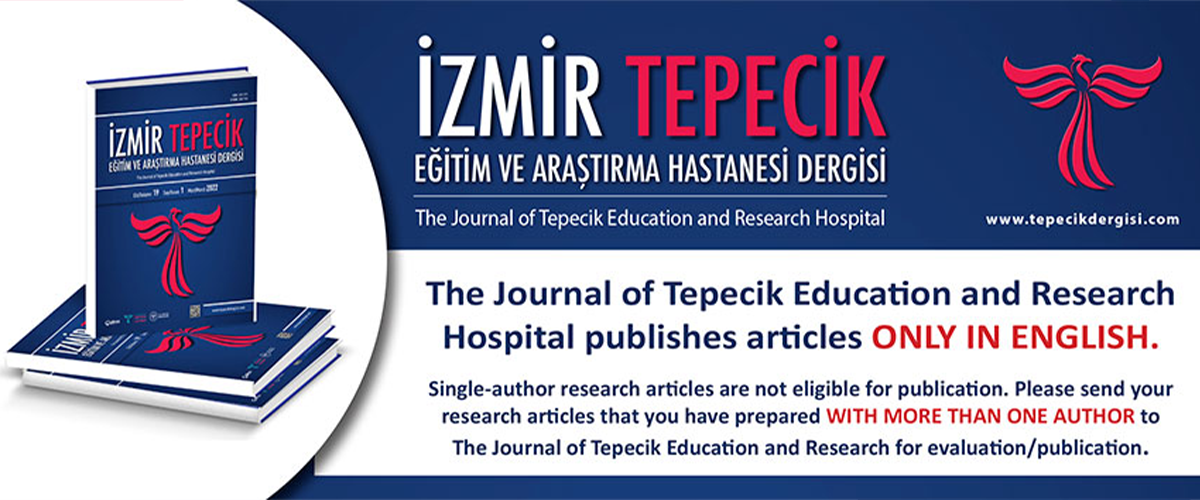








The Rate Of Development Postnatal Obstructive Uropathy In Fetal Hydronephrosis
Önder Yavaşcan0, Sinem Akbay0, Şervan Özalkak0, Murat Kangın0, Alkan Bal0, Fulya Kamit Can0, Pınar Kuyum0, Cefa Nil Arslan0, Cevriye Kübra Cenkçi0, Nejat Aksu0Aim: The widespread utilization of prenatal ultrasonography and the detection of antenatal hydronephrosis have raised the importance of postnatal follow-up of these infants. In this study, we aimed to determine the importance of an early diagnosis for the management of obstructive urinary tract malformations as well as postnatal radiographic and scintigraphic examinations in infants with obstructive uropathy. Material and Method: Infants whose antenatal ultrasonography showed a fetal renal pelvis of 5 mm or greater were investigated postnatally using ultrasonography (7-10th day, 1. month) and voiding cystourethrography (1. month). Infants with vesicoureteral reflux were excluded; 169 patients (222 kidney units) were included in the study. All cases with or without obstructive uropathy as well as patients with obstructive uropathy, who required surgery or no surgery, were evaluated in terms of urinary tract infection, anterior-posterior pelvic diamater on ultrasonography, scars on scintigraphy with Technetium 99m dimercaptosuccinic acid(Tc-99) and differential functions on scintigraphy with Tc- 99. Statistical evaluation was performed using the chi-square and student’s t-tests. Findings: In this study, 54 neonates (71 kidney units) were found to have obstructive uropathy. The median duration of postnatal follow-up was 40 months (range: 12–106 months). The most common detected underlying abnormality was ureteropelvic junction obstruction (in 39 kidney units). The annual urinary tract infection frequency was higher in cases with obstructive uropathy (0.95±0.92 episode/year) than in cases without abnormality (0.41±0.42 episode/year) (p<0.01). Final anteriorposterior pelvic diamater was higher both in cases with obstructive uropathy (14.8±7.8 mm) and in cases who underwent surgery (19±7.7 mm) than in cases without abnormality (8.5±1.6 mm) and in cases who required no surgery (11.7±5.7 mm), respectively (p<0.01). Frequency of scars on scintigraphy with Tc-99m was higher in cases with obstructive uropathy (45 % in first visit, 47 % in final visit) than in cases without obstruction (1.3% in first and final visits) (p<0.01). Conclusion: To evaluate the infants with antenatal hydronephrosis by performing serial ultrasound and other radiological imaging techniques after the first week of postnatal period and to continue close monitoring allow us early recognition of the presence of obstructive uropathy and facilitate for deciding the need for surgery.
Keywords: Antenatal hydronephrosis,Fetal hydronephrosis, Neonatal obstructive uropathy, Postnatal ultrasonographyFetal Hidronefrozlu Olgularda Doğum Sonrasında Obstrüktif Üropati Gelişme Oranları
Önder Yavaşcan0, Sinem Akbay0, Şervan Özalkak0, Murat Kangın0, Alkan Bal0, Fulya Kamit Can0, Pınar Kuyum0, Cefa Nil Arslan0, Cevriye Kübra Cenkçi0, Nejat Aksu0Amaç: Gebelikte ultrasonografinin yaygın kullanımı ve doğum öncesi hidronefrozun artan sıklıkta tanımlanmasıyla, bu hastaların doğum sonrasında izlemin önemi giderek artmaktadır. Bu çalışmada doğmalık üriner sistem malformasyonlarının önemli bir bölümünü oluşturan obstrüktif üropatilerin tedavisinde erken tanının ve obstrüktif üropatili çocukların tanısal sürecinde kullanılan radyolojik ve sintigrafik tetkiklerin önemini araştırmayı amaçladık. Gereç ve Yöntem: Doğum öncesinde yapılan ultrasonografi ile fetal renal pelvis çapı 5 mm ve üstünde olan bebekler doğum sonrasında ultrasonografi (7-10 gün, 1. ay) ve miksiyosistoüreterografi yöntemleriyle araştırıldı. Vezikoüreteral reflü tanısı alanlar çıkarıldıktan sonra 169 (222 böbrek birimi) hasta çalışmaya alındı. Obstrüktif üropati saptanan ve saptanmayan tüm hastalar ile obstrüksiyon saptanan hastalardan opere olanlar ve olmayanlar idrar yolu infeksiyonu sayısı, ultrasonografide ön arka pelvis çapı, Teknesyum 99m dimerkaptosüksinik asit(Tc-99) sintigrafisinde skar durumu, Tc-99 sintigrafisinde diferansiyel işlev açısından değerlendirildi. İstatistiksel değerlendirmede ki-kare ve student’s t-testleri kullanıldı. Bulgular: Çalışmamızda, 54 bebekte (71 böbrek birimi) obstrüktif üropati saptandı. Bu bebeklerin ortanca doğum sonrası izlem süresi 40 ay (12–106 ay) olarak belirlendi. Üreteropelvik bileşke darlığı en sık saptanan anomali olarak tespit edildi (39 böbrek birimi). Yıllık idrar yolu infeksiyonu sıklığı obstrüktif üropati saptanan olgularda (0.95±0.92/yıl), saptanmayan olgulardan (0.41±0.42/yıl) yüksek bulundu (p<0.01). Son değerlendirmedeki böbrek pelvis ön arka çapları obstrüktif üropati saptanan (14.8±7.8 mm) olgularda saptanmayanlara (8.5±1.6 mm) ve opere olan hastalarda (19±7.7 mm), olmayanlara (11.7±5.7 mm) göre yüksek bulundu (p<0.01). Tc-99 sintigrafisinde skar saptanma oranı obstrüktif üropatili olgularda (ilk değerlendirme % 45, son değerlendirme % 47), saptanmayan olgulara (ilk ve son değerlendirme % 1.3) göre yüksek bulundu (p<0.01). Sonuç: Doğum öncesinde hidronefroz saptanan bebeklerin doğum sonrasında yaşamlarının ilk haftasından itibaren seri ultrasonografi ve sintigrafik görüntüleme yöntemleri ile değerlendirilmesi ve aynı şekilde izlenmeye devam edilmesi üriner sistemde var olan obstrüktif patolojinin erken dönemde tanınmasını ve opere edilmesi gereken olguların belirlenmesinde kolaylık sağlayacaktır.
Anahtar Kelimeler: Doğum öncesi hidronefroz, Doğum sonrası ultrasonografi,Fetal hidronefroz,Yenidoğan obstrüktif üropatisiManuscript Language: Turkish
(1158 downloaded)




